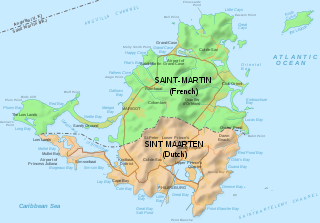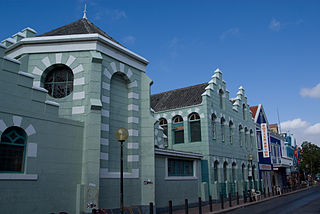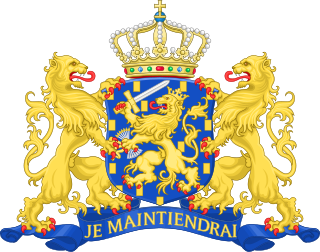Sint Maarten is a constituent country of the Kingdom of the Netherlands.
Sint Maarten, Sint-Maarten or Sint Martinus may also refer to:

The Netherlands Antilles, also known as the Dutch Antilles, was a constituent Caribbean country of the Kingdom of the Netherlands consisting of the islands of Saba, Sint Eustatius, and Sint Maarten in the Lesser Antilles, and Aruba, Curaçao, and Bonaire in the Leeward Antilles. The country came into being in 1954 as the autonomous successor of the Dutch colony of Curaçao and Dependencies, and it was dissolved in 2010, when like Aruba in 1986, Sint Maarten and Curaçao gained status of constituent countries within the Kingdom of the Netherlands, and Saba, Sint Eustatius, and Bonaire gained status of special municipality of Netherlands as the Caribbean Netherlands. The neighboring Dutch colony of Surinam in continental South America, did not become part of the Netherlands Antilles but became a separate autonomous country in 1954. All the territories that belonged to the Netherlands Antilles remain part of the kingdom today, although the legal status of each differs. As a group they are still commonly called the Dutch Caribbean, regardless of their legal status. People from this former territory continue to be called Antilleans in the Netherlands.

Saint Martin is an island in Leeward Islands of the Lesser Antilles in the northeastern Caribbean, approximately 300 km (190 mi) east of Puerto Rico. The 87 km2 (34 sq mi) island is divided roughly 60:40 between the French Republic and the Kingdom of the Netherlands, but the Dutch part is more populated than the French. Divided since 1648, the northern French part comprises the Collectivity of Saint Martin and is an overseas collectivity of the French Republic. The southern Dutch part comprises Sint Maarten and is one of four constituent countries that form the Kingdom of the Netherlands. Even though the island is an overseas possession of two European Union member states, only the French part of the island is part of the EU.
Saint Martin may refer to:

The SSS islands, locally also known as the Windward Islands, is a collective term for the three territories of the Dutch Caribbean that are located within the Leeward Islands group of the Lesser Antilles in the Caribbean Sea. In order of population size, they are: Sint Maarten, Sint Eustatius, and Saba. In some contexts, the term is also used to refer to the entire island of Saint Martin, alongside Sint Eustatius and Saba.

The Sint Maarten national football team is the football team of Sint Maarten, the Dutch half of the Caribbean island of Saint Martin, and is controlled by the Sint Maarten Football Federation. Sint Maarten is not a member of FIFA, and therefore not eligible to enter the World Cup. However, the association applied for FIFA membership in 2016 but was rejected. In April 2022, the Sint Maarten Football Federation appealed to the CAS against FIFA’s ruling.

"O Sweet Saint Martin's Land", also known by its French title, "Saint-Martin, si jolie", is the bi-national song of Saint-Martin / Sint Maarten island, an island divided between the French Republic and the Kingdom of the Netherlands. It was written in English by Gerard Kemps in 1958. Kemps also wrote and composed a French version with its own lyrics and a different tune.

Sint Maarten is a constituent country of the Kingdom of the Netherlands located in the Caribbean region of North America. With a population of 58,477 as of June 2023 on an area of 34 km2 (13 sq mi), it encompasses the southern 44% of the divided island of Saint Martin, while the northern 56% of the island constitutes the French overseas collectivity of Saint Martin. Sint Maarten's capital is Philipsburg. Collectively, Sint Maarten and the other Dutch islands in the Caribbean are often called the Dutch Caribbean.

The flag of Sint Maarten consists of a white triangle situated at the hoist charged with the constituent country's coat of arms, along with two horizontal bands of cherry red and navy blue. Adopted in 1985 shortly after the territory was granted a coat of arms, it has been the flag of Sint Maarten since 13 June of that year. Since the dissolution of the Netherlands Antilles on 10 October 2010, it has been the sole flag used in the constituent country.

The Catholic Church in the Caribbean part of the Kingdom of the Netherlands is part of the worldwide Roman Catholic Church, under the spiritual leadership of the Pope in Rome.

The Kingdom of the Netherlands, commonly known simply as the Netherlands, is a sovereign state consisting of a collection of constituent territories united under the monarch of the Netherlands, who functions as head of state. The realm is not a federation; it is a unitary monarchy with its largest subdivision, the eponymous Netherlands, predominantly located in Northwestern Europe and with several smaller island territories located in the Caribbean.
The Franco-Dutch treaty on Saint Martin border controls, sometimes shortened to the Franco-Dutch treaty and in full the Treaty between the Kingdom of the Netherlands and the French Republic on the control of persons entering Saint Martin through the airports, is a treaty between France and the Netherlands aimed at improving border controls at the two airports on the divided island of Saint Martin. The island is divided into French Saint-Martin and Dutch Sint Maarten.

A common visa exists since the end of 2010 for the territories of Aruba, Curaçao, Sint Maarten and the Caribbean Netherlands which form together the territory of the Kingdom of the Netherlands in the Caribbean. The visa is not valid for the European part of the Netherlands, which is part of the Schengen Area.

Sint Maarten, a constituent country of the Kingdom of the Netherlands, has a government formed by the monarch, represented by the governor, and the ministers. The Prime Minister of Sint Maarten presides over the council of ministers. Executive power is exercised by the government. Legislative power is vested in both the government and parliament. The minister plenipotentiary is not part of the government and represents the Sint Maarten government in the Netherlands. The judiciary is independent of the executive and the legislature. The country is a parliamentary representative democratic country with a multi-party system. Sint Maarten has full autonomy on most matters, with the exceptions summed up in the Charter for the Kingdom of the Netherlands under the title "Kingdom affairs". The Constitution of Sint Maarten was ratified in September 2010, and entered into force on 10 October 2010.

.sx is the country code top-level domain (ccTLD) in the Domain Name System of the Internet for Sint Maarten.

The Dutch Caribbean are the New World territories, colonies, and countries of the Dutch Empire and the Kingdom of the Netherlands located in the Caribbean Sea, mainly the northern and southwestern regions of the Lesser Antilles archipelago.

Sint Maarten, a country within the Kingdom of the Netherlands, started issuing postal stamps after the dissolution of the Netherlands Antilles on 10 October 2010. The island thus became one of the five postage regions in the Kingdom of the Netherlands. The first stamp issued showed the map of the island Saint Martin.

The economy of Saint Martin, divided between the French Collectivity of Saint Martin and the Dutch Sint Maarten, is predominately dependent on tourism. For more than two centuries, the main commodity exports have generally been salt and locally grown commodities, like sugar.
In Sint Maarten, a Dutch Caribbean constituent country of the Kingdom of the Netherlands, foreign policy is set by the Netherlands but all other laws including those related to abortion are self-determined. Abortion in Sint Maarten is illegal, although it may be permissible in circumstances where a pregnancy threatens the woman's life. Despite its illegality, abortions are routinely performed by some medical practitioners and are ignored by authorities.

The Saint Martin–Sint Maarten border, or France–Netherlands border, is the border between the Collectivity of Saint Martin, an overseas collectivity of France, and Sint Maarten, a constituent country of the Kingdom of the Netherlands, on the island of Saint Martin in the Caribbean. The 87-square-kilometre (34 sq mi) island is divided roughly 60:40 between the French Republic and the Kingdom of the Netherlands by the 16 km (10 mi) border. However, the two parts are roughly equal in population.

The unification of Saint Martin is the proposed unification of the small island of Saint Martin, located in the Caribbean Sea. Currently, it is divided into Sint Maarten and the Collectivity of Saint Martin. The island has been divided since the signing of the Treaty of Concordia in 1648, which today remains as one of the oldest treaties still in effect.